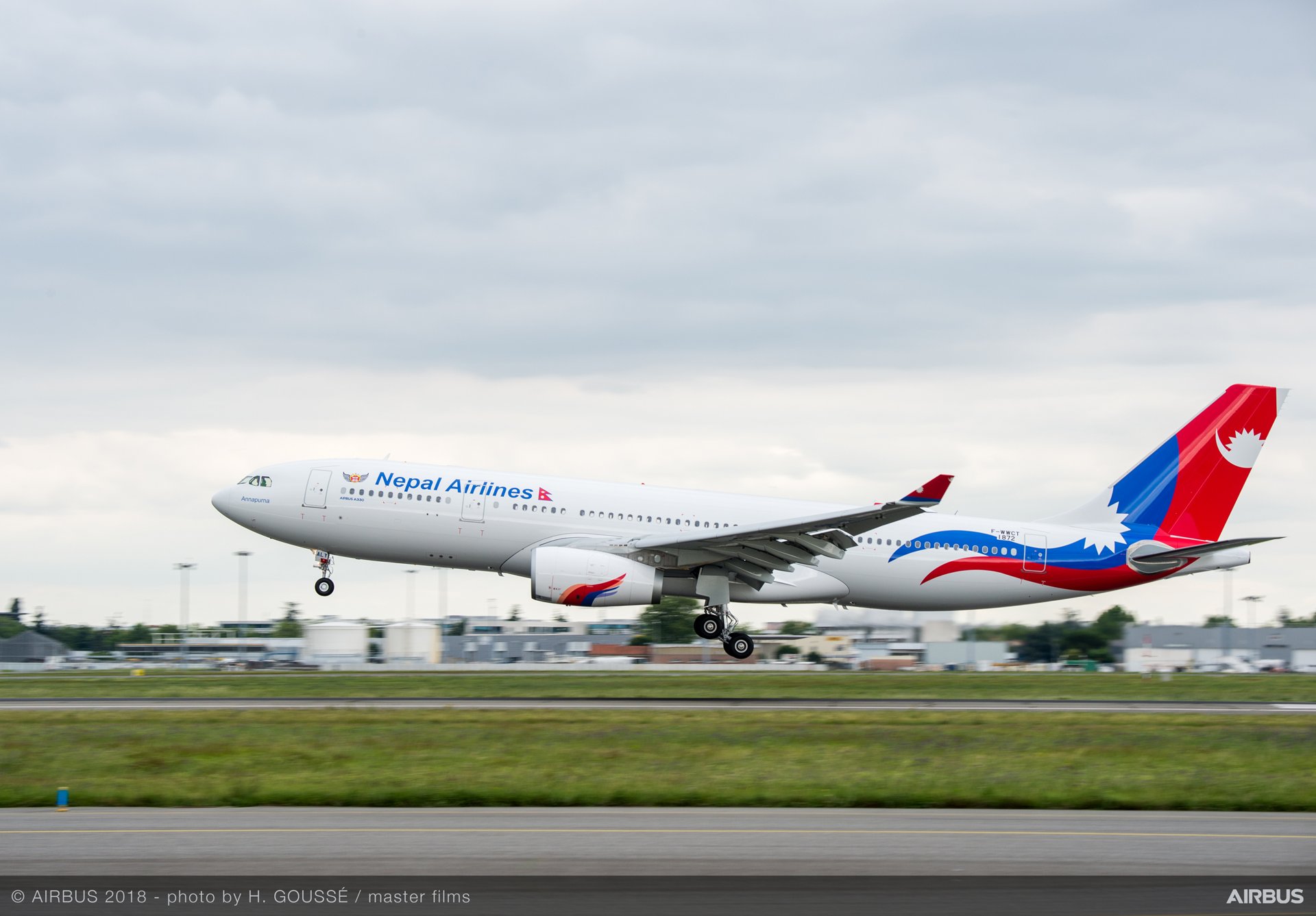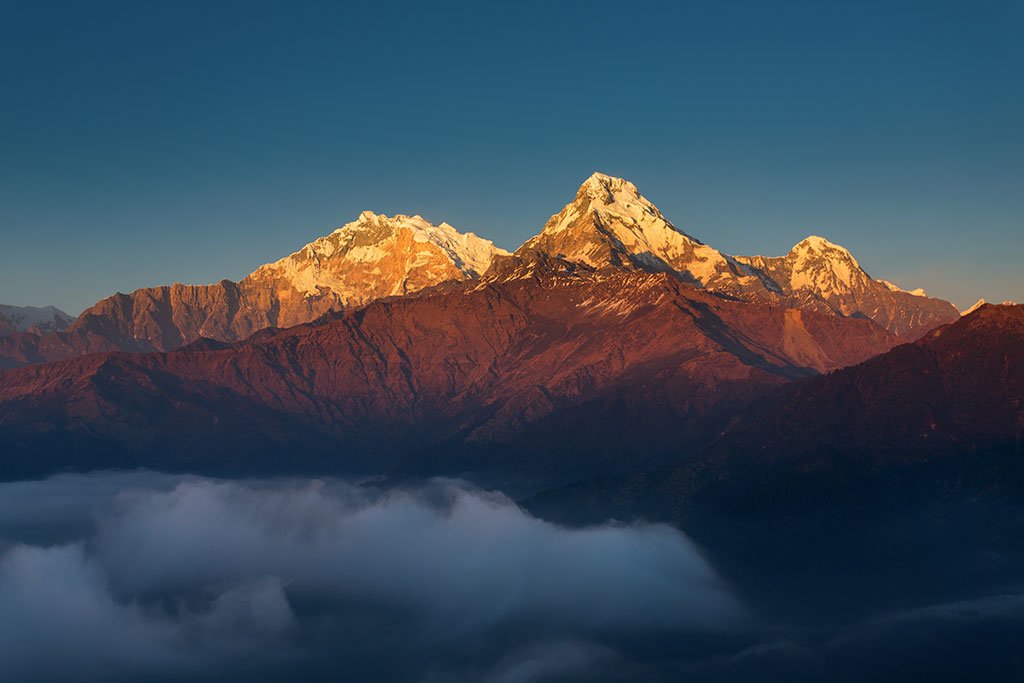Trip Overview
Discover the Beauty of the Ghorepani Poon Hill Trek
The Ghorepani Poon Hill trek stands out as one of the premier trekking destinations in Nepal’s Annapurna Himalayan region, offering a perfect blend of natural beauty and cultural richness. This adventure begins in Pokhara, a magnificent and dreamy city beloved by travelers for its serene lakes, vibrant atmosphere, and stunning mountain views.
From Pokhara, the trail winds through picturesque valleys, lush forests, and cascading waterfalls, leading trekkers towards the renowned Poon Hill. Named after the local Poon family who reside in Ghorepani at its base, Poon Hill is a convergence point for three major trekking routes: from Tikhedhunga, Tatopani, and Tadapani. This hill station is celebrated for its breathtaking sunrises over the Himalayas, offering stunning views of the Mt. Dhaulagiri Range, Mt. Nilgiri, Mt. Annapurna Range, Mt. Manaslu, and Lamjung Himal. The early morning ascent to Poon Hill is a highlight of the trek, providing panoramic vistas that are truly unforgettable.
As you journey along the trail, you’ll have the opportunity to visit Ghandruk, a historically significant village that is home to the Gurkha warriors who fought in World War II. The village offers a unique glimpse into the lives and traditions of the Gurung people, known for their rich cultural heritage and traditional attire. In Ghandruk, you can visit the Gurung family museum, where traditional Gurung dress (Bhangra and Ghalek), ancient weapons (such as traditional guns), and everyday items from the past are preserved. This museum offers an insightful look into the history and culture of the Gurung community.
The Ghorepani Poon Hill trek is not just about the stunning landscapes; it is also a journey through the vibrant cultural heritage of the Gurung and Magar people. These ethnic groups are known for their hospitality, traditional dances, and colorful festivals. Along the trek, you will have the chance to interact with the local villagers, learn about their way of life, and enjoy their warm hospitality. The trek offers a unique opportunity to explore the rich culture and traditional attire of these communities, making it a culturally enriching experience.
Whether you’re an avid trekker or a casual adventurer, the Ghorepani Poon Hill trek promises an unforgettable journey through Nepal’s stunning landscapes and vibrant cultural heritage. The trek is suitable for all levels of trekkers, offering a moderate challenge that is rewarded with incredible views and cultural experiences. The well-maintained trails, comfortable teahouse accommodations, and the ever-changing scenery make this trek a favorite among both novice and experienced trekkers.
In conclusion, the Ghorepani Poon Hill trek is a must-do for anyone looking to experience the beauty of the Annapurna region. From the charming city of Pokhara to the majestic views from Poon Hill, this trek offers a perfect combination of natural beauty and cultural immersion. Whether you are seeking a serene escape or an adventurous journey, the Ghorepani Poon Hill trek will leave you with lasting memories and a deep appreciation for the stunning landscapes and rich cultural heritage of Nepal.
Tour Highlight
- Explore the vibrant city of Kathmandu
- Discover the beauty of Pokhara, with its serene lakes and mountain views
- Witness breathtaking sunrise and sunset views from Poon Hill
- Experience the rich Gurung culture in Ghandruk village
- Walk through colorful rhododendron forests and diverse landscapes
Trip Facts
Trip Itinerary Expand All
Arrival in Kathmandu
Kathmandu to Pokhara
Pokhara to Tikhedhunga (1,570 meters)
- Travel: Drive from Pokhara to Nayapul (1.5 hours), then trek to Tikhedhunga (4-5 hours).
- Highlights: Walk through lush forests, terraced fields, and picturesque villages, crossing several suspension bridges.
Tikhedhunga to Ghorepani (2,840 meters)
- Trek Duration: 6-7 hours
- Highlights: Ascend the steep stone staircase to Ulleri, traverse rhododendron forests, and enjoy views of the Annapurna and Dhaulagiri ranges.
Ghorepani to Poon Hill (3,210 meters) to Tadapani (2,610 meters)
- Activities: Early morning hike to Poon Hill for a spectacular sunrise over the Himalayas. Descend back to Ghorepani for breakfast, then trek to Tadapani.
- Trek Duration: 6-7 hours
- Highlights: Panoramic views of Mt. Dhaulagiri, Mt. Nilgiri, Mt. Annapurna, Mt. Manaslu, and Lamjung Himal; walk through dense forests.
Tadapani to Ghandruk (1,940 meters)
- Trek Duration: 3-4 hours
- Highlights: Descend through rhododendron and oak forests to reach Ghandruk, a culturally rich Gurung village.
- Activities: Explore the traditional Gurung culture, visit the Gurung museum, and learn about the local lifestyle.
Ghandruk to Nayapul and Return to Pokhara
- Trek Duration: 4-5 hours
- Travel: Trek from Ghandruk to Nayapul, then drive back to Pokhara.
- Highlights: Enjoy the scenic descent through villages and farmlands, return to the comforts of Pokhara.
Pokhara to Kathmandu
- Travel: Fly (25 minutes) back to Kathmandu.
- Activities: Free time to explore Kathmandu, shop for souvenirs, or visit local attractions.
Departure from Kathmandu
- Activities: Transfer to the airport for your onward journey.
- Highlights: Reflect on your trekking adventure and the beautiful memories made.
What Includes & Excludes
Includes
Accommodation
- Two Nights Hotel Accommodation in Kathmandu in BB plan
- Two Nights Hotel Accommodation in Pokhara in BB plan
Guides and Porters
- Trekking Porters – We Assign a porter for each two trekkers.
- An English speaking local guide
Meals
- Three Meals (Breakfast, Lunch and Dinner)
Transports
- From and to the airport transfer to the hotel on a private tourist vehicle
- All ground transportation as per itinerary
- Kathmandu to Pokhara Round trip in Tourist Bus
Additional Services
- All government taxes and official expenses.
- Farewell dinner one night before the client’s final departure in a typical Nepali Restaurant with culture dance. Your guide will accompany you.
- Trekking/tour permits, entrance fees.
- Accommodation, foods, insurance, salary, equipment, and medicine for field staffs.
Excludes
- Anything not mentioned in the price includes.
- Personal trekking gears/equipment.
- Tips for trekking staff (Tipping is expected).
- Lunch and dinner in the city.
- All drinks including bottled/boiled water along the trekking route
- Visa fees and travel insurance.
- International airfare to and from Nepal.
Guest Reviews
We highly recommend Broad Adventures they provided exceptional guidance on our Everest Base Camp trek. Our guide’s Gynau’s professionalism,...
Read More...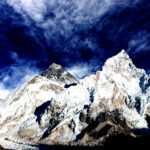
David Neufeld
CanadaIf you are looking for a tour to see the Mt Everest base camp look no further. I have...
Read More...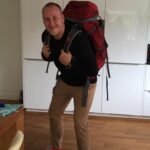
Tim Troost
AustraliaI was looking at an exotic trek adventure. After looking for a bunch of places to go I thought...
Read More...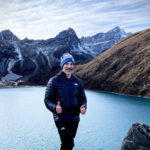
Keith B.
USAKeshab was our most gracious and amiable guide in Kathmandu and to Everest basecamp. My wife accompanied me on...
Read More...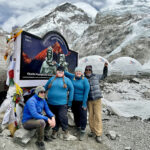
Ken Byers , Nevada
USAMy son and I went for trekking in Nepal in 2009, and we were lucky to have Keshab Khanal...
Read More...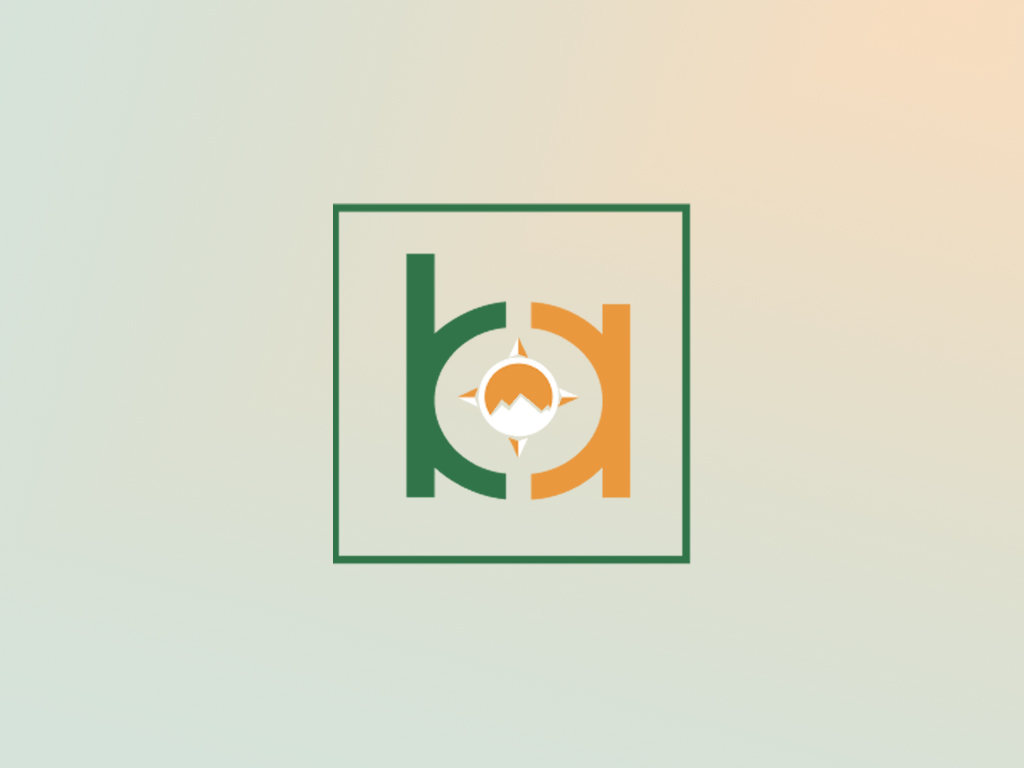
Dr. Raphael Hemmendinger
Jerusalem , IsraelIn 2005 I came to Nepal for the second time, this time whith a very specific queste. I wanted...
Read More...
Richard Rijken
Amsterdam , NetherlandsI was always willing to go to the Himalayas and explore some of the beauties hidden in the sacred...
Read More...
John Peter
Manchester , United KingdomNamaste! This was my first time to Nepal, and I had an amazing time on my trek. From the...
Read More...
David Patrician
Hamburg , GermanyI was on trekking from 24.10.10 to 5.11.10 in the half part of Annapurna circuit from Bhulbhule to Jomsom....
Read More...
Vaya Bairaba
Athens , GreeceImportant Info
The Ultimate Guide to Poon Hill Ghorepani Trek
1. Accessibility
Ghorepani Poon Hill trek is easily accessible and popular among trekkers. The journey typically starts from Pokhara, Nepal’s second-largest city, renowned for its scenic beauty and laid-back atmosphere. From Pokhara, a drive to Nayapul marks the beginning of the trek. This initial drive takes about 1.5 to 2 hours and is well connected by road.
How to Get There:
- From Kathmandu to Pokhara: You can fly (25-30 minutes) or take a tourist bus (6-8 hours).
- From Pokhara to Nayapul: Accessible by car or bus, taking approximately 1.5 to 2 hours.
2. Difficulty Level
The Ghorepani Poon Hill trek is considered to be of moderate difficulty, making it suitable for trekkers of various experience levels. The trek involves walking for about 4-6 hours a day on well-marked trails with some steep ascents and descents.
Preparation Tips:
- Regular cardiovascular exercise and light strength training.
- Comfortable trekking shoes and layered clothing.
- Adequate hydration and rest.
3. Highest Point
The highest point of the Ghorepani Poon Hill trek is Poon Hill, which stands at 3,210 meters (10,531 feet). Poon Hill is famous for its spectacular sunrise views over the Himalayas, including Annapurna South, Annapurna I, Dhaulagiri, and Machapuchare.
Highlights:
- Sunrise views of the Annapurna and Dhaulagiri ranges.
- Panoramic Himalayan vistas.
4. Connectivity
While trekking, connectivity is generally good in the lower regions, but it becomes spotty as you ascend. Most teahouses offer Wi-Fi, but the quality can vary, and it becomes more expensive higher up.
Tips for Staying Connected:
- Purchase a local SIM card (Ncell or NTC) in Kathmandu or Pokhara.
- Carry a power bank for charging devices.
- Use messaging apps that work with limited connectivity.
5. Driving Road
The road from Pokhara to Nayapul is well-maintained and suitable for vehicles. The drive is scenic, passing through lush landscapes and local villages.
Road Conditions:
- Paved and accessible year-round.
- Scenic drive with views of lush landscapes and local villages.
6. Flight Connection
The nearest airport is in Pokhara, which has frequent flights from Kathmandu. These flights offer spectacular aerial views of the Himalayas and save significant travel time.
Flight Details:
- Duration: 25-30 minutes.
- Airlines: Yeti Airlines, Buddha Air, and other domestic carriers.
- Booking: Book in advance during peak trekking seasons (spring and autumn).
7. Elevation Guide and AMS (Acute Mountain Sickness)
- Pokhara (827 meters / 2,713 feet): Starting city.
- Nayapul (1,070 meters / 3,510 feet): Trek starting point.
- Tikhedhunga (1,540 meters / 5,052 feet): First stop.
- Ghorepani (2,850 meters / 9,350 feet): Base for Poon Hill.
- Poon Hill (3,210 meters / 10,531 feet): Highest point of the trek.
Preventing AMS:
- The risk of AMS is low due to the moderate altitude of the trek.
- Ascend gradually and allow your body to acclimatize.
- Stay hydrated and avoid alcohol.
- Be aware of AMS symptoms: headache, nausea, dizziness.
8. Luxury Options
While the Ghorepani Poon Hill trek is traditionally a teahouse trek, there are luxury lodges that provide enhanced comfort and amenities.
Luxury Lodges:
- Ker & Downey Lodges: Known for excellent service and comfort.
- Gurung Lodge: Offers cultural experiences along with luxury.
9. Camping Options
Though the trek is popular for its teahouses, camping is an option for those who prefer a more immersive experience in nature.
Camping Essentials:
- High-quality tents and sleeping bags.
- Portable cooking equipment.
- Permits and guide arrangements through a trekking agency.
10. Heli Ride Options
For those seeking a luxurious and time-efficient option, helicopter rides to and from Poon Hill are available. These rides offer an unforgettable aerial view of the Himalayas.
Heli Ride Details:
- Duration: 15-20 minutes from Pokhara to Ghorepani.
- Cost: Varies depending on group size and provider.
- Booking: Can be arranged through trekking agencies or directly with helicopter companies in Pokhara.
Get Trip PDF file
Why travel with
Broad Adventures
Since 2010, we have curated unique itineraries that offer once-in-a-lifetime experiences, ensuring every trip is filled with joy and adventure. Our focus on the fun factor and the right amount of challenge allows you to achieve a profound sense of personal accomplishment, all while enjoying the camaraderie of like-minded travelers.
Small-Group Adventures
Join an intimate group of like-minded travelers who share your passion for discovering the world's wonders safely and confidently. Our small group settings foster a deeper connection with your fellow explorers and the incredible destinations we visit.
Expert Local Guides
We exclusively employ local guides and porters for their unparalleled knowledge and expertise. Their insights and firsthand experiences enrich your journey, giving you a deeper understanding and appreciation of the local culture, history, and environment.
Responsible for Tourism
Your safety is our utmost priority. Our dedicated team of trained professionals ensures the highest standards of care, including providing fresh and hygienic meals, comprehensive First Aid supplies, and round-the-clock communication services. We are committed to responsible tourism practices, emphasizing the importance of sustainable and ethical travel.
Health and Saftey
Promoting responsible tourism is essential, as it calls for a collective effort from everyone involved in the industry. By prioritizing health and safety, we ensure that each journey is not only enjoyable but also respectful of the destinations and communities we visit.
How can we help you?
- City Tour Equipment
- City Tour Season
- Climbing Equipment
- Climbing Season
- General Questions
- Guide and Staffs
- Nepal Overview
- Tipping
- Transportations
- Trekking Equipment
- Trekking Season
- VISA info
- Weather and Temperature
Do you provide any equipment for the trek?
Broad Adventure provides you a basic equipment like a Sleeping Bag and a down Jacket, for the tea-house trek. And for the climbing trip, we provide the basic equipment. For a camping trek check it once including the section.
What is the time zone of Nepal?
NPT (UTC+05:45)
What cultural attractions can I explore in Kathmandu?
Kathmandu is home to historical sites like Durbar Square, Swayambhunath (Monkey Temple), and Pashupatinath Temple. These landmarks showcase Nepal’s rich cultural and religious heritage, providing visitors with a deep insight into the country’s history.
What are the must-visit cities in Nepal?
Kathmandu, Pokhara, Bhaktapur, and Patan are popular cities offering rich cultural experiences. Each city has its own unique charm, historical sites, and vibrant local markets.
Do you provide any equipment for the trek?
Broad Adventure provides you a basic equipment like a Sleeping Bag and a down Jacket, for the tea-house trek. And for the climbing trip, we provide the basic equipment. For a camping trek check it once including the section.
Do I need to tip the guide and porters? What is the standard tip?
Tips is expected by your team members and normally the standard is 10% of your total trip cost.
What is the climbing season in Nepal?
The main climbing seasons are spring (April to May) and autumn (September to November). During these times, the weather is more stable, providing safer and more favorable conditions for climbing expeditions.
Are there other mountains in Nepal suitable for climbing?
Yes, Nepal is home to numerous trekking peaks and mountains suitable for climbing, such as Island Peak, Mera Peak, and Lobuche East. These peaks offer a challenging yet rewarding experience for climbers of various skill levels.
Can I climb Mount Everest as a tourist?
Climbing Mount Everest requires significant preparation, experience, and permits. Most climbers join organized expeditions with experienced guides. Climbing Everest is a serious undertaking that demands physical fitness, technical skills, and a high level of commitment.
Do I need to tip the guide and porters? What is the standard tip?
Tips is expected by your team members and normally the standard is 10% of your total trip cost.
What is the voltage and plug type used in Nepal?
The standard voltage is 230V, and the plug type is the Europlug (Type C) and the British-style plug (Type D). It’s advisable to bring adapters if necessary.
What is the voltage and plug type used in Nepal?
The standard voltage is 230V, and the plug type is the Europlug (Type C) and the British-style plug (Type D). It’s advisable to bring adapters if necessary.
Is it necessary to get travel insurance for Nepal?
Yes, travel insurance is highly recommended, especially for trekking and adventure activities. Ensure that your insurance covers medical emergencies, evacuation, and trip cancellations.
What languages are spoken in Nepal?
The official language is Nepali, but English is widely understood in tourist areas. Additionally, various ethnic groups have their own languages.
What is the currency used in Nepal, and are credit cards widely accepted?
The official currency is the Nepalese Rupee (NPR). While major cities and tourist areas accept credit cards, it’s advisable to carry cash in remote areas. ATMs are available in urban centers.
How can I get around within cities in Nepal?
Transportation options include taxis, rickshaws, and local buses. Walking is also a great way to explore the cities, especially in the old quarters. Many cities have well-preserved historic areas, and navigating them on foot allows for a more immersive experience.
What cultural attractions can I explore in Kathmandu?
Kathmandu is home to historical sites like Durbar Square, Swayambhunath (Monkey Temple), and Pashupatinath Temple. These landmarks showcase Nepal’s rich cultural and religious heritage, providing visitors with a deep insight into the country’s history.
Can I climb Mount Everest as a tourist?
Climbing Mount Everest requires significant preparation, experience, and permits. Most climbers join organized expeditions with experienced guides. Climbing Everest is a serious undertaking that demands physical fitness, technical skills, and a high level of commitment.
Are permits required for trekking in Nepal?
Yes, trekking permits are required for most trekking regions. The type of permit depends on the specific trekking area. It’s important to obtain the necessary permits from the respective authorities to support local conservation and management efforts.
When is the best season for treks in Nepal?
From March to mid-June and September to December is the best season for treks.
What is the fitness required for the treks?
Generally, to trek in Nepal we should have good physical and health conditions. And also able to walk 4- 7 hours in day at a high altitude with your little backpack.
Do you pick me up at the Airport upon my arrival?
Yes, our airport representative welcomes you at the airport and transfers you to the hotel in a private tourist vehicle.
Does my guide/porter speak English?
They speak English. All the guides are professional and due to their professionalism, they speak good English. The guide’s English is enough to explain the local culture, activities, and religions.
Are the treks and tours secured? What about the security?
Providing security to our clients is our principal. The government-licensed holder guides and other crew members are carefully assigned for your trip. Even though, would like to counsel you to take care of your equipment, and bags. If you doing a tea-house trek your accommodation is in a local guesthouse, where you have to be a precaution yourself at all times. And if you are on a camping trek always keep your bags inside the tent and while at nighttime please keep your bag in the middle of the tent. The camping leader assigns a Sherpa as a guard throughout the nighttime.
What sort of ground transportation do you use?
Normally we assign a car for up to 2 people and a Jeep for up to 5 people and then a bus for up to 14 PAX and Coster and Sutlej Bus depending on group size. There are some trekking routes, which are dirt roads for them we assign 4WD Jeeps. It also depends on what services you opt for.
Are the staff insured by your company?
Yes, all of the staff and crew members are insured.
Should I need to join the group?
Joining a group depends on your booking and the option that you choose. If you have booked for Private Trip then obviously you will not join. Otherwise, normally the same trip departs on the same day then the group will join.
Do you arrange a private trip?
Yes, of course, we will arrange a private tour.
How big is a group size?
We will try to arrange a small group of willing people, which immortalize the treks. Normally we encompass 12 -16 people in a group. (This is not to apply to those who want to do a Private Trip, no minimum and maximum for them.)
Is the drinking water okay? Or do I need to use tablets?
For drinking water you can buy bottled water and purified mineral water on tea-house treks and city tours. And in the camping trek, the camping cook provides you with boiled water. For some cases of remote area trekking it would be better to have some purification tablets that you can buy in Kathmandu.
What are the accommodations and meals like?
All the meals that you provided are hygienic and fresh. While you are on a camping trek you get meals prepared by a professional camping cook. And if you are doing a tea-house trek you will get the main course as like in the cities. For accommodation on the camping trek, you will have a tent with good-quality mattresses and a sleeping bag. And if you are on a tea-house trek you will normal twin-sharing room with basic facilities with a warm mattress and blanket, and also we provide a sleeping bag if you need it.
Is the shower facility during the tour/trek?
Yes, you can have a shower during the trek. In the camping trek, you will get a shower in a shower tent which is provided 3-4 times in the whole trek, depending on the duration of the trek. And in a tea-house trek, we will provide you attached room where possible and for the rest of town, you will pay for a shower.
Do you provide any equipment for the trek?
Broad Adventure provides you a basic equipment like a Sleeping Bag and a down Jacket, for the tea-house trek. And for the climbing trip, we provide the basic equipment. For a camping trek check it once including the section.
Is there any possibility of communicating in my hometown?
Yes, you can. In the Everest and Annapurna regions, you can connect via Phone, or Internet both available in most of the town and, in some remote routes, you may need to use a satellite phone that is carried by your trek guide or also get in the local town.
Can I charge the batteries of cameras, and phones?
Yes, you can charge your devices, but recommended you bring your plugs, and chargers and also do not leave unattended anything while charging in a lobby or somewhere in the trekking guesthouse. And if you are on a camping trek it’s quite hard to charge the phone so we advise you to bring a portable charge.
Are there any health precautions I should take before traveling to Nepal?
Vaccinations for diseases like typhoid, hepatitis, and tetanus are advisable. Altitude sickness prevention measures should be considered for high-altitude treks.
How can I find a reliable trekking guide in Nepal?
Reliable guides can be found through licensed trekking agencies, recommendations from fellow travelers, or by checking with the Nepal Tourism Board. Ensure that your guide has the necessary permits and is experienced in the chosen trekking region
Is hiring a local guide recommended for exploring Nepal?
Yes, hiring a local guide is highly recommended, especially for trekking and exploring remote areas. Guides provide valuable insights into the culture, history, and geography of the region, ensuring a safer and more enriching experience.
Is hiring a local guide recommended for exploring Nepal?
Yes, hiring a local guide is highly recommended, especially for trekking and exploring remote areas. Guides provide valuable insights into the culture, history, and geography of the region, ensuring a safer and more enriching experience.
Is Nepal a safe country for tourists?
Yes, Nepal is considered safe for tourists. However, like any travel destination, it’s essential to follow common-sense safety practices and stay updated on travel advisories. Local people are welcoming, and the country values its reputation as a safe and friendly destination.
What is the best time to visit Nepal?
The best time to visit Nepal is during the spring (March to May) and autumn (September to November) seasons when the weather is generally favorable for outdoor activities. During these periods, the skies are clear, and the temperatures are moderate.
What makes Nepal a popular tourist destination?
Nepal is renowned for its stunning Himalayan landscapes, rich cultural heritage, diverse wildlife, and warm hospitality. The country offers a unique blend of adventure, spirituality, and natural beauty.
What is the standard tip?
Tipping is subjective so it depends on your satisfaction. However, the standard is about 20% of the trip cost you can share with the staff.
Do I need to tip the guide and porters? What is the standard tip?
Tips is expected by your team members and normally the standard is 10% of your total trip cost.
Do you provide any equipment for the trek?
Broad Adventure provides you a basic equipment like a Sleeping Bag and a down Jacket, for the tea-house trek. And for the climbing trip, we provide the basic equipment. For a camping trek check it once including the section.
Are permits required for trekking in Nepal?
Yes, trekking permits are required for most trekking regions. The type of permit depends on the specific trekking area. It’s important to obtain the necessary permits from the respective authorities to support local conservation and management efforts.
Do I need a guide for trekking in Nepal?
While it’s not mandatory, hiring a local guide is highly recommended for safety, navigation, and cultural insights. Guides are familiar with the terrain, can provide valuable information about the region, and ensure a smoother trekking experience.
What are the most popular trekking destinations in Nepal?
The Everest Base Camp trek, Annapurna Circuit, Langtang Valley trek, and Manaslu Circuit are among the most popular trekking routes in Nepal. Each trek offers unique experiences, from breathtaking mountain views to encounters with diverse cultures.
When is the best season for treks in Nepal?
From March to mid-June and September to December is the best season for treks.
Do I need to tip the guide and porters? What is the standard tip?
Tips is expected by your team members and normally the standard is 10% of your total trip cost.
Can I extend my tourist visa to Nepal?
Yes, tourist visas can be extended at the Department of Immigration in Kathmandu or the Immigration Office in Pokhara. Extension fees and requirements vary, and it’s advisable to initiate the process a few days before the current visa expires.
What documents are required for a tourist visa on arrival?
Passport with at least six months validity, a completed visa application form (available at the airport), and two passport-sized photos are required. Additionally, visa fees must be paid in cash (USD or equivalent).
What are the types of visas available for tourists?
Tourist visas are available for duration ranging from 15 to 90 days. Extensions can be obtained within Nepal if needed. Other visa categories include business visas, student visas, and diplomatic visas, each with specific requirements.
How do I obtain a visa for Nepal?
Tourist visas for Nepal can be obtained upon arrival at Tribhuvan International Airport in Kathmandu or at various land entry points. Alternatively, you can apply for a visa at the Nepalese embassy or consulate in your home country before traveling.
What is the monsoon season in Nepal?
The monsoon season in Nepal runs from June to early September. During this time, the country receives heavy rainfall, particularly in the southern plains and the hilly regions. The monsoon brings lush green landscapes but can also cause landslides and flooding in some areas.
What is the time zone of Nepal?
NPT (UTC+05:45)

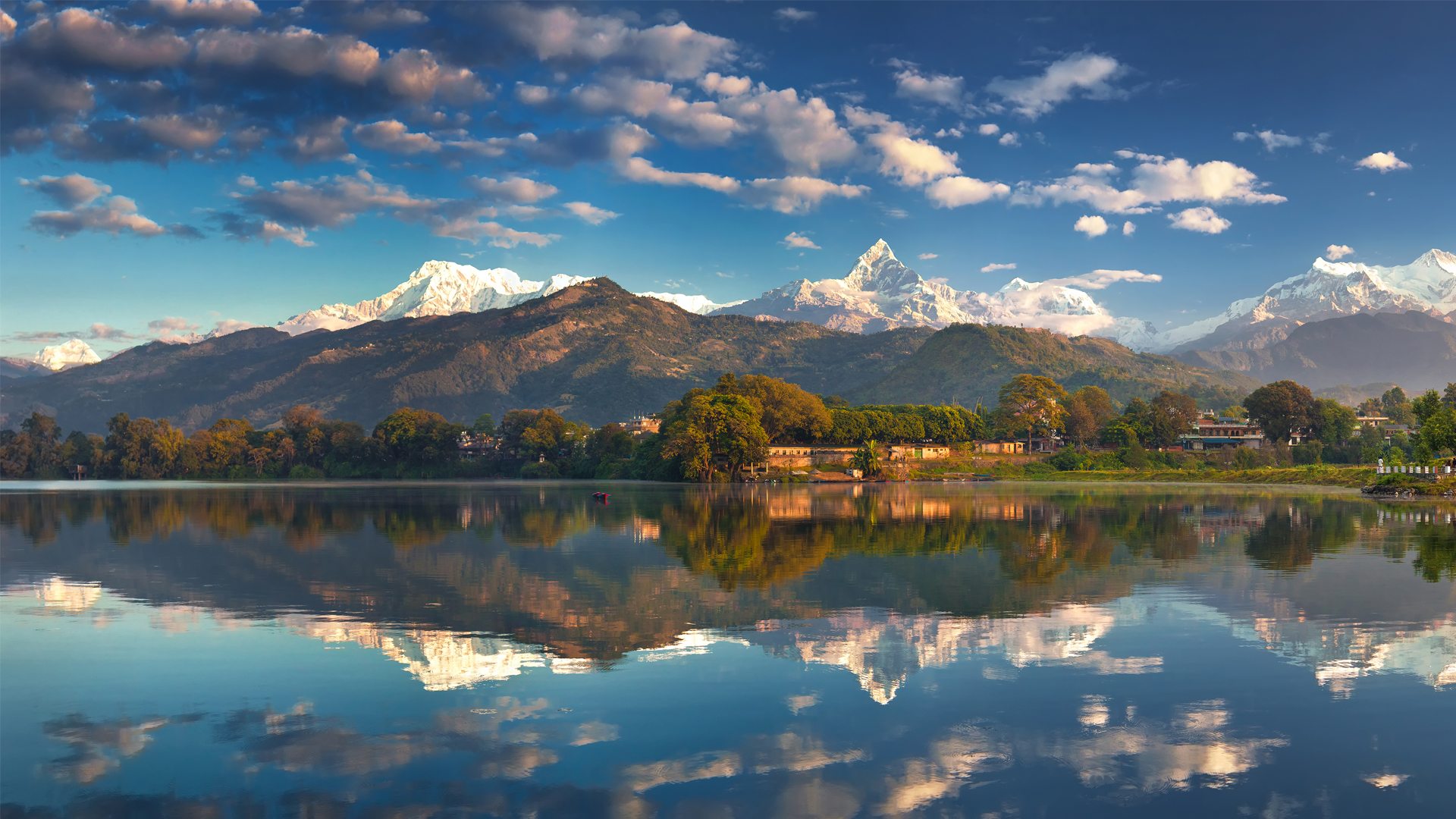
 Group Size: 2 PAX Mimimum
Group Size: 2 PAX Mimimum  Duration: 9 Days
Duration: 9 Days  Trip Start: Kathmandu
Trip Start: Kathmandu  Trip End: Kathmandu
Trip End: Kathmandu  Average Dist. per Day: 6 KM
Average Dist. per Day: 6 KM  Average Time per Day: 5-6 Hrs
Average Time per Day: 5-6 Hrs  Trip Grading: Easy
Trip Grading: Easy 